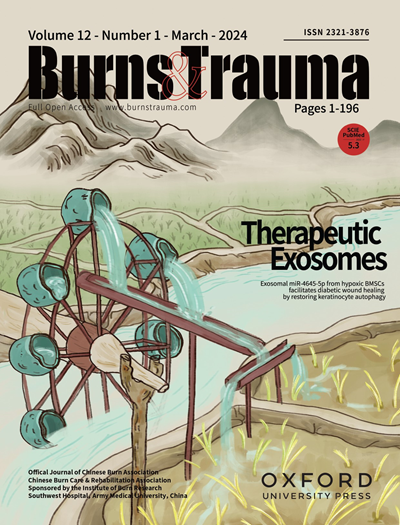压缩载荷下Th12椎体切除后胸腰椎节段经椎弓根固定变异体的数学建模
IF 6.3
1区 医学
Q1 DERMATOLOGY
引用次数: 0
摘要
背景。胸腰椎连接处的特点是负荷较大,对稳定的要求增加,这不仅要提供可靠和刚性的固定,而且要确保金属结构和骨组织的所有元素上负荷的最大均匀分布,以排除长期固定失败。本研究的目的是探讨在轴向压缩载荷的影响下,椎弓根螺钉长度和交联的存在对手术切除胸腰椎交界处一节椎体的载荷分布的影响。材料和方法。我们分析了部分胸腰椎(Th9-L5)的数学有限元模型,其中Th12椎体被切除并用椎间植入物取代,并通过椎弓根系统进行额外固定。采用短螺钉和长螺钉,以及带和不带两个交联,模拟了四种不同的经椎弓根固定。研究了在350 n垂直分布压荷载作用下模型的应力-应变状态。当使用短螺钉和无交联时,Th10、Th11、L1和L2椎体的最大应力分别为7.2、5.3、4.2和14.3 MPa,而使用无交联的长螺钉时为6.5、4.6、3.8和13.5 MPa。短螺杆和交联的模型分别为7.1、4.4、3.9和14.0 MPa,长螺杆和交联的模型分别为6.3、4.5、3.5和13.2 MPa。结论。在压缩载荷下,使用长螺钉可以降低模型骨单元的应力水平,使用交联可以为经椎弓根结构的后部支持提供更大的刚度,这导致固定螺钉上的应力增加,但可以降低骨组织中的应力水平。本文章由计算机程序翻译,如有差异,请以英文原文为准。
Mathematical modeling of variants of thoracolumbar junction transpedicular fixation after resection of Th12 vertebra under compressive load
Background. The area of the thoracolumbar junction is characterized by a significant load that dictates increased requirements to stabilization, which should not only provide a reliable and rigid fixation, but also ensure the maximum uniform distribution of the load on all elements of both the metal structure and the bone tissue to exclude the failure of fixation in the long run. Purpose of the study is to investigate the influence of the transpedicular screw length and the presence of crosslinks on the load distribution during surgical resection of one vertebra from the thoracolumbar junction under the influence of axial compressive load. Materials and methods. We analyzed mathematical finite-element model of the part of thoracolumbar spine (Th9-L5), where the Th12 vertebra was removed and replaced by an interbody implant with additional fixation by a transpedicular system. Four variants of transpedicular fixation were modeled using short and long screws, as well as with and without two crosslinks. The stress-strain state of the models was studied under the influence of a vertical compressive distributed load of 350 N. Results. When using short screws and in the absence of crosslinks, the maximum stresses in the Th10, Th11, L1, and L2 vertebrae are 7.2, 5.3, 4.2, and 14.3 MPa, respectively, when using long screws without crosslinks — 6.5, 4.6, 3.8 and 13.5 MPa. The model with short screws and crosslinks shows 7.1, 4.4, 3.9 and 14.0 MPa, while the application of long screws with crosslinks is 6.3, 4.5, 3.5 and 13.2 MPa, respectively. Conclusions. With a compressive load, the use of long screws allows to reduce the level of stress in the bone elements of the models, the use of crosslinks provides greater rigidity to the posterior support of the transpedicular structure, which leads to an increase in stress on the fixing screws but allows to reduce the level of stress in the bone tissue.
求助全文
通过发布文献求助,成功后即可免费获取论文全文。
去求助
来源期刊

Burns & Trauma
医学-皮肤病学
CiteScore
8.40
自引率
9.40%
发文量
186
审稿时长
6 weeks
期刊介绍:
The first open access journal in the field of burns and trauma injury in the Asia-Pacific region, Burns & Trauma publishes the latest developments in basic, clinical and translational research in the field. With a special focus on prevention, clinical treatment and basic research, the journal welcomes submissions in various aspects of biomaterials, tissue engineering, stem cells, critical care, immunobiology, skin transplantation, and the prevention and regeneration of burns and trauma injuries. With an expert Editorial Board and a team of dedicated scientific editors, the journal enjoys a large readership and is supported by Southwest Hospital, which covers authors'' article processing charges.
 求助内容:
求助内容: 应助结果提醒方式:
应助结果提醒方式:


